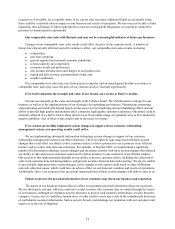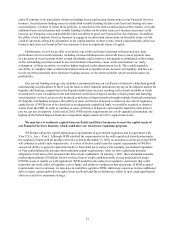Cabela's 2010 Annual Report Download - page 23
Download and view the complete annual report
Please find page 23 of the 2010 Cabela's annual report below. You can navigate through the pages in the report by either clicking on the pages listed below, or by using the keyword search tool below to find specific information within the annual report.13
the business and macroeconomic environment and, ultimately, the revenue and profitability of our business. In
an economic environment characterized by higher unemployment, lower family income, and lower consumer
spending, the demand for our products could be adversely affected. This may materially affect our business and
results of operations.
Competition in the outdoor recreation and casual apparel and footwear markets could reduce our
revenue and profitability.
The outdoor recreation and casual apparel and footwear markets are highly fragmented and competitive. We
compete directly or indirectly with the following types of companies:
• other specialty retailers that compete with us across a significant portion of our merchandising categories
through retail store or direct businesses, such as Bass Pro Shops, Gander Mountain, Orvis, The
Sportsman’s Guide, and Sportsman’s Warehouse;
• large-format sporting goods stores and chains, such as The Sports Authority, Dick’s Sporting Goods, and
Big 5 Sporting Goods;
• retailers that currently compete with us through retail businesses that may enter the direct business;
• mass merchandisers, warehouse clubs, discount stores, and department stores, such as Wal-Mart and
Target; and
• casual outdoor apparel and footwear retailers, such as L.L. Bean, Lands’ End, and REI.
Many of our competitors have a larger number of stores, and some of them have substantially greater market
presence, name recognition, and financial, distribution, marketing, and other resources than we have. In addition,
if our competitors reduce their prices, we may have to reduce our prices in order to compete. Furthermore, some
of our competitors have aggressively built new stores in locations with high concentrations of our Direct business
customers. As a result of this competition, we may need to spend more on advertising and promotion. Some of
our mass merchandising competitors, such as Wal-Mart, do not currently compete in many of the product lines
we offer. If these competitors were to begin offering a broader array of competing products, or if any of the other
factors listed above occurred, our revenue could be reduced or our costs could be increased, resulting in reduced
profitability.
If we are unable to comply with the terms of our credit arrangements, especially the financial
covenants, our unsecured revolving credit facility could be terminated and our unsecured senior notes could
become due and payable.
Our $350 million unsecured revolving credit facility and unsecured senior notes contain certain financial
covenants, including the maintenance of minimum debt coverage, a fixed-charge coverage ratio, a cash flow
leverage ratio, and a minimum tangible net worth standard. We may not be able to satisfy these ratios, especially
if our operating results deteriorate as a result of, but not limited to, adverse economic conditions or the impact
of other risk factors that may have a negative impact on our business and results of operations. A breach of any
financial covenant or our inability to comply with the required financial ratios could result in a default under our
unsecured revolving credit facility and unsecured senior notes, and we can provide no assurance that we would
be able to obtain the necessary waivers or amendments from our lenders to remedy a default. In the event of any
default that is not waived, the lenders under our unsecured revolving credit facility are not required to lend any
additional amounts or issue letters of credit and could require us to apply all of our available cash to collateralize
any outstanding letters of credit and declare any outstanding borrowings, together with accrued interest and other
fees, to be immediately due and payable. In addition, the holders of our unsecured senior notes could declare all
outstanding amounts, together with accrued interest and other fees, to be immediately due and payable.
We may not be able to raise additional capital or obtain additional financing if needed.
Volatility in the equity and debt markets, tightening of the credit markets, and the worldwide economic
environment could make it more difficult for us to raise additional capital or obtain additional financing, and
jeopardize the counterparty obligations of one or more of the banks participating in our $350 million unsecured
revolving credit facility. We cannot be certain that additional funds will be available if needed and to the extent
























